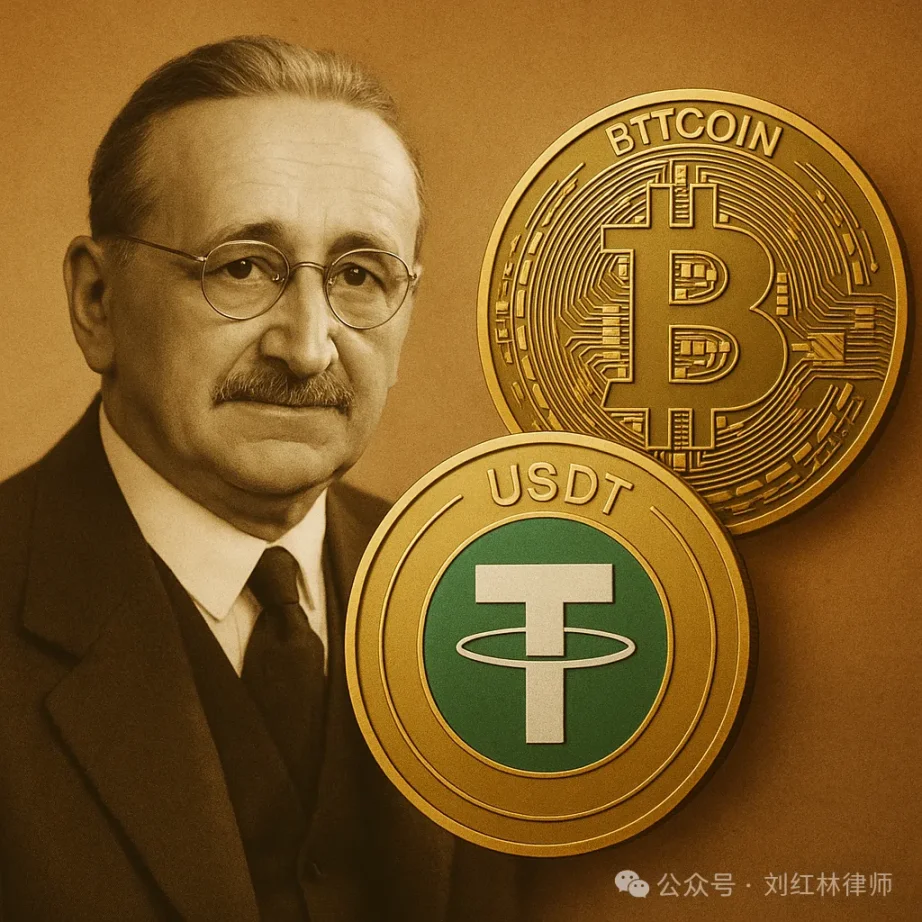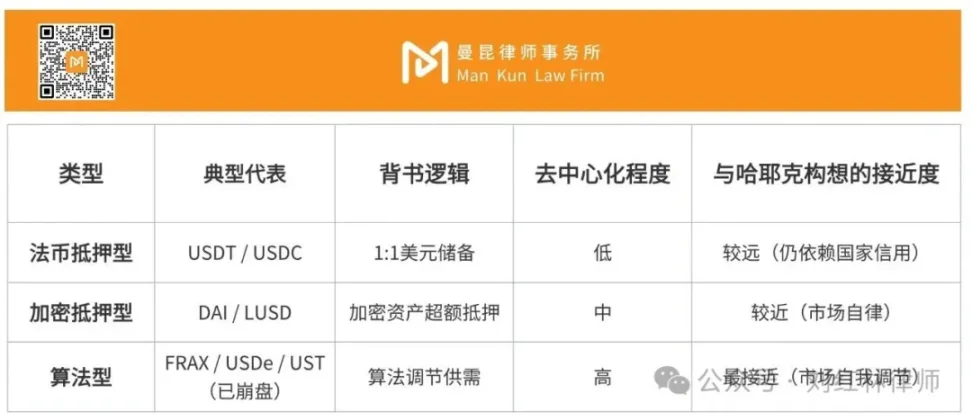Author: Liu Honglin
Hayek maintained a vigilant distance from state power throughout his life.
He did not believe that the state could manage currency well, just as he did not believe that a planned economy could arrange for people's freedom. In 1976, he published "The Denationalization of Money," proposing a revolutionary idea—that currency should be issued by private entities, with the market determining its quality.
At that time, the world was still swaying in the afterglow of the Bretton Woods system. The free currency competition envisioned by Hayek seemed like nothing more than a scholar's dream: who would allow "private currency" to circulate in reality?
But fifty years later, stablecoins in the Web3 world are unexpectedly reviving this dream on the blockchain.

Hayek: Returning Currency to the Market
In Hayek's view, the state monopoly on currency issuance is the root cause of modern inflation and financial cycles.
Governments dilute debt through inflation and cover up fiscal deficits, while the public bears the cost of wealth depreciation.
He proposed: "Allow private institutions to issue currency freely, and let the public choose which currency to use."
The market will automatically punish unstable and untrustworthy currency issuers while rewarding stable and reliable currencies—
just like consumers choose products.
This idea later became known as the "theory of competitive supply of money."
In Hayek's imagination, currency was no longer a "sovereign" defined by the state,
but a "contractual credit" generated by market competition.
However, in the 1970s, no technology could support this concept.
The accounting, clearing, and credit verification of currency all relied on centralized institutions.
It wasn't until 2008, when Satoshi Nakamoto released the Bitcoin white paper, that Hayek's nearly forgotten book suddenly found new readers.
Bitcoin: The De-nationalization of Currency in Practice
The invention of Bitcoin was a rebellion against monetary thought.
It does not rely on central bank issuance, nor on state endorsement; its total supply is fixed, its algorithms are public, and its ledger is transparent.
This is precisely the prototype of the "denationalized currency" that Hayek desired.
However, Bitcoin also exposed the first paradox of "market currency": price stability.
Its scarcity guarantees resistance to inflation but also leads to extreme volatility—
a "free currency" that cannot serve as a stable medium of exchange will only become a speculative asset.
What Hayek wanted was stable credit, while Bitcoin offered market frenzy.
Thus, stablecoins emerged.
Stablecoins: The "Revised Version" of Denationalized Currency
The emergence of stablecoins represents a compromise between technology and credit.
They retain the openness of decentralized systems while introducing anchoring mechanisms to ensure price stability.
In this regard, they are closer to Hayek's envisioned "private currency" than Bitcoin.
Based on collateral and issuance mechanisms, stablecoins can be roughly divided into three categories:
Fiat-collateralized (e.g., USDT, USDC): Issued by the issuer who holds an equivalent amount of US dollars or short-term debt assets, tokens are issued on a 1:1 basis on-chain and redeemed upon exchange. The advantages are stability and strong liquidity; the disadvantages are a strong reliance on the banking system and regulatory arrangements, resulting in low decentralization.
Crypto-collateralized (e.g., DAI, LUSD): Users over-collateralize with ETH, BTC, etc., to mint stablecoins on-chain; prices are maintained through liquidation mechanisms, interest rate adjustments, and oracles. The advantages are on-chain self-discipline and transparency; the disadvantages are susceptibility to fluctuations in crypto assets and liquidation efficiency.
Algorithmic / Hybrid (e.g., FRAX, USDe, and the failed UST): Attempting to achieve "soft anchoring" through supply adjustments, derivatives hedging, or partial collateralization. The advantages are stronger capital efficiency and decentralization; the disadvantages are vulnerability in extreme market conditions, where slight design flaws can lead to a "death spiral."

From an institutional logic perspective, these stablecoins are practicing Hayek's core proposition:
Making currency a product of market competition.
Institutions or communities like Tether, Circle, and MakerDAO have effectively become "private central banks."
They issue currency and maintain its stability based on algorithms, collateral, or market trust.
Users no longer choose which currency to use due to state coercion, but based on trust and convenience.
This is precisely the "free currency competition" scenario that Hayek longed for.
However, in reality, stablecoins are still far from the ideal of "denationalized currency," facing three significant challenges.
(1) Anchoring to the Dollar: The Illusion of Denationalization
The vast majority of stablecoins are pegged to the US dollar.
Although they are issued by private entities, they still operate within the dollar system.
The essence of USDT is a shadow bank using government bonds and commercial paper
to "digitally recreate" dollar credit on the blockchain.
This is not the denationalization of currency, but rather the recolonization of the dollar.
Stablecoins superficially weaken the state's monetary sovereignty, but in reality, they reinforce America's monetary hegemony.
Hayek may not have anticipated that his dream of "currency competition" would transform into a "technological extension of the dollar" in the reality of globalization.
(2) The Resurgence of Regulation: The Tug-of-War Between Freedom and Order
Hayek hoped that the currency market could form a self-ordering system through competition,
but the systemic risks of the modern financial system have made regulation necessary.
The US SEC, FinCEN, EU MiCA, Hong Kong SFC…
are all incorporating stablecoins into a licensing management system in different ways.
Circle actively seeks regulatory cooperation, while MakerDAO attempts to maintain "compliance neutrality."
This game reflects a rebalancing between liberalism and sovereign order.
The ideal of decentralization must land within a legal framework—
the denationalization of currency ultimately still faces the re-embedding of state regulation.
(3) Algorithmic Credit: A New Form of "Trust Economy"
Hayek believed that the market would punish bad money, but the collapse of algorithmic currencies indicates that algorithmic credit does not automatically equate to market trust.
The collapse of TerraUSD (UST) revealed that "free currency" can also self-destruct.
Algorithms cannot replace the central bank's role as the lender of last resort.
The shift of credit from the state to algorithms is merely a transition from one political belief to another.
The essence of currency—its organizational form of trust—has not changed.
Nevertheless, stablecoins have allowed Hayek's vision to be concretely realized on a global scale for the first time.
The "currency competition" he envisioned now occurs in the form of network protocols:
On-chain, anyone can issue, hold, and exchange their own currency;
the market chooses trust based on price, liquidity, and transparency;
algorithms and smart contracts take on part of the functions of credit order.
If Bitcoin completed the ideological enlightenment of "currency denationalization,"
then stablecoins are the institutional experiment of "denationalized currency."
It is not a revolution, but a reconstruction.
The state is no longer the sole creator of currency;
the market, technology, and communities jointly participate in the production of credit.
Hayek believed that spontaneous order is the driving force of human institutional evolution.
And blockchain is the modern form of this force.
Without central planning, without sovereign coercion,
order can emerge from code and consensus.
The existence of stablecoins proves this point.
Conclusion: The Future of Currency
Hayek's thorough "denationalization" may never be fully realized, but the future of currency is indeed moving from "single sovereignty" to "multi-centered order."
In this new system:
Sovereign currencies continue to exist, serving as the foundation for finance and payments;
stablecoins become a medium of exchange in cross-border and on-chain economies;
algorithmic credit, RWA collateral, and central bank digital currencies (CBDCs) coexist and compete;
law and algorithms jointly define the "trust boundaries" of currency.
This represents a new pluralism in currency.
Hayek might be surprised to find that his "theory of private currency" is being reinterpreted in the 21st century in China, Hong Kong, Dubai, and the Ethereum community—
not as complete laissez-faire, but as a search for a new balance between regulation and technology.
Stablecoins may not be the ultimate realization of Hayek's vision, but they allow us to re-understand the social essence of "currency":
Trust need not be monopolized; credit can be distributed.
In this sense, stablecoins are indeed a revival of Hayek.
Only this time, the revived spirit is not in a café in Vienna, but in the consensus network of the blockchain.
免责声明:本文章仅代表作者个人观点,不代表本平台的立场和观点。本文章仅供信息分享,不构成对任何人的任何投资建议。用户与作者之间的任何争议,与本平台无关。如网页中刊载的文章或图片涉及侵权,请提供相关的权利证明和身份证明发送邮件到support@aicoin.com,本平台相关工作人员将会进行核查。




